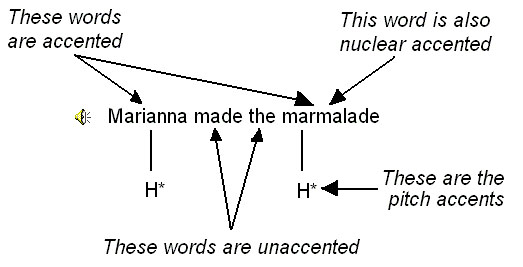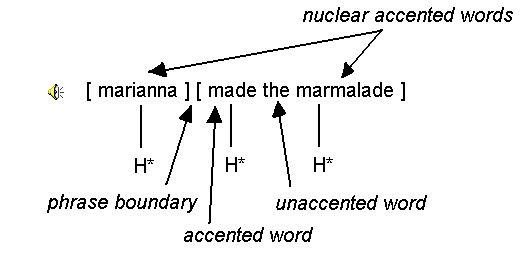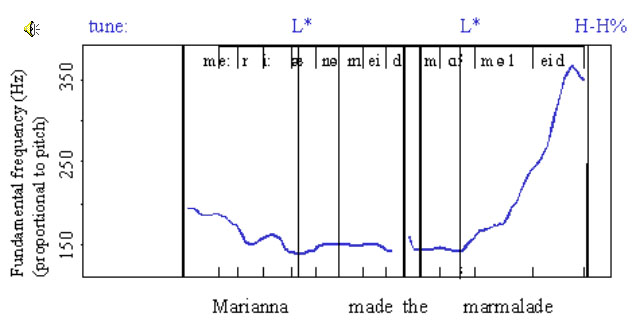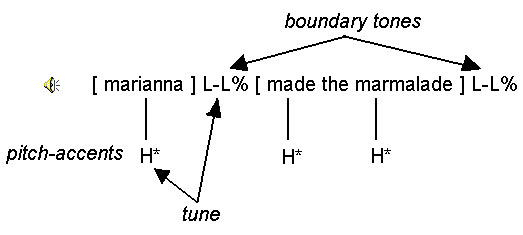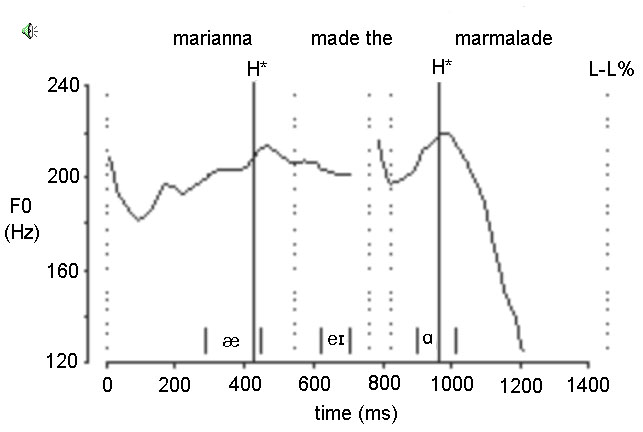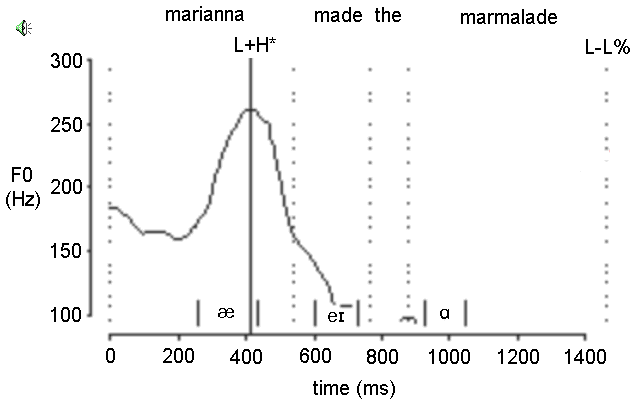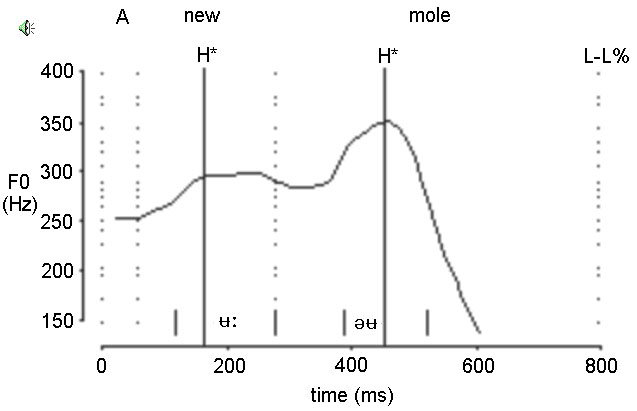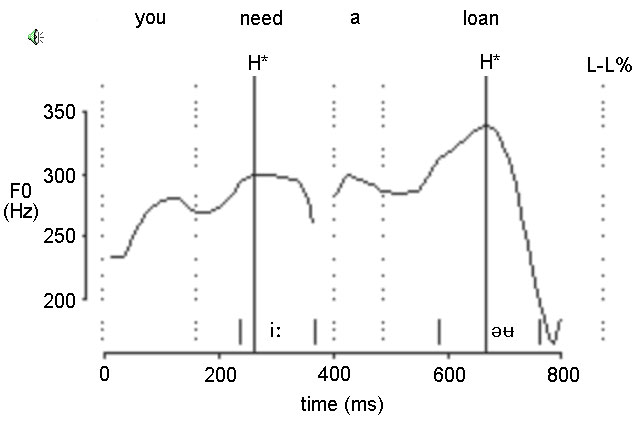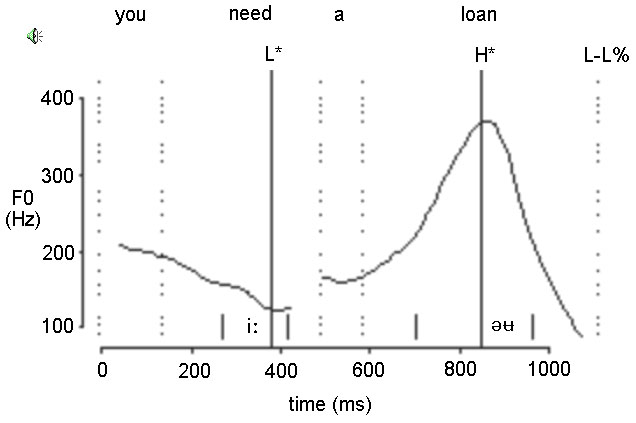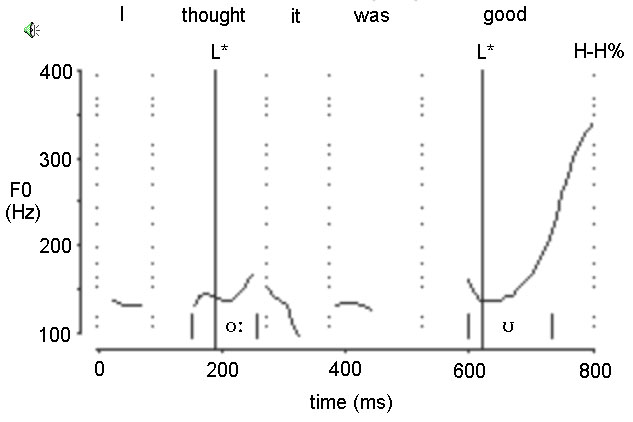Intonation - ToBI introduction
Introduction to the phonology of intonation
Jonathan Harrington
Important: You must have installed the phonetic font "Charis SIL" or tested this installation to determine if the phonetic characters installed properly.
Sentence or utterance prosody
Sentence-stress or accent
Some words sound more prominent - they 'stand out' to a greater extent than others.
The relative prominence of words depends very much on how the intonation is associated with the words, or with the text, of the utterance. Above all, the same string of words can be accented in different ways.
|
Listen to the sound below: [Marianna made the marmalade] |
Listen to the sound below: [Marianna made the marmalade] |
Prosodic phrasing
The same set of words can be broken up into prosodic phrases in different ways. At the boundaries between prosodic phrases we often hear a change in the rhythm of the speech or a pause.
|
Listen to the sound below: [Marianna made the marmalade] |
Intonation
The same set of words can be associated with any number of different tunes that are signaled by the rise and fall in pitch -- there is always one tune for each prosodic phrase
|
Listen to the sound below: [Marianna made the marmalade] |
How do we hear accented words?
One of the main reasons why we hear certain accented words as prominent is because of intonation. Specifically, a speaker synchronises a unit of intonation known as a pitch-accent with the vowel of the primary stressed syllable of each word that is accented. We represent this as follows:
Another unit of sentence stress is known as the nuclear accent. The last accented word in any prosodic phrase is nuclear accented.
(Prosodic phrase is still to be defined: assume that there's one prosodic phrase above that extends from the beginning to the end of the sentence).
Prosodic phrases
Every utterance consists of one or more prosodic phrases.
In every prosodic phrase, there is one (and only one) nuclear accented word.
You can often hear if an utterance has more than one prosodic phrase because:
- You can sometimes hear a pause between intonational phrases
- A speaker 'slows down' at the end of a prosodic phrase which makes the last syllable a bit longer (known as phrase-final lengthening).
- There can be a marked change in pitch either at, or just before the end, of a prosodic phrase.
Two example prosodic phrases
|
Listen to the sound below: Amongst her friends she was considered beautiful |
|
Listen to the sound below: The museum hires musicians every evening |
Intonation and tunes
Speakers can select one of a number of tunes to be associated to each prosodic phrase.
The anatomy of a tune
A tune is composed of:
- pitch accents: H* or L*
- boundary tones: L-L%, L-H%, H-H%, H-L%
The association of tune and prosodic phrase
- one pitch accent is associated to each accented word
- one boundary tone is associated to the end of each prosodic phrase
Pitch-accents
|
H* There should be a pitch peak on, or near, the accented word's primary stressed vowel. Preceding consonant is voiced (e.g. 'bit') |
L* There should be a pitch trough, on, or near, the accented word's primary stressed vowel | |
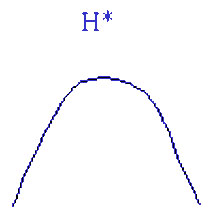 | 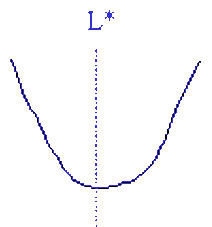 | |
| Sometimes this is labeled L+H* if there is a long rise to the peak |
Examples of H* tones
Examples of H* and L* tones
Boundary tones
A boundary tone influences the pitch contour between the tone target of the nuclear accented word and the right boundary of the prosodic phrase

(the part of the pitch contour influenced by the boundary tone is shown by the horizontal line with arrows)
There are four kinds of boundary tones…
1. L-L% boundary tone
| L-L% | The pitch ends at a low value at the end of the prosodic phrase |
| This boundary tone is common in 'neutral' statements. |
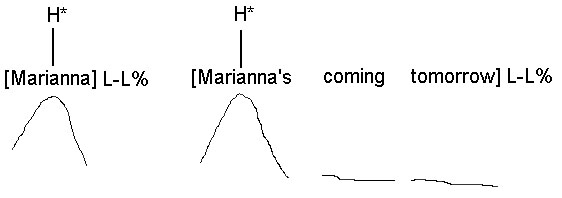
The L-L% boundary tone causes the pitch to be low after the tone target of the nuclear accented word; if there are only one or two syllables after the last H* tone target (left), the result is a fall in pitch; if many syllables follow the H* tone target, then the pitch falls as before, but then stays low to the end of the phrase (right)
2. H-H% boundary tone
| H-H% | The pitch ends at a high value at the prosodic boundary |
| "Yes-no" questions: "did you say Melbourne?" | |
| In many statements in Australian English (known as high-rising-terminals). |
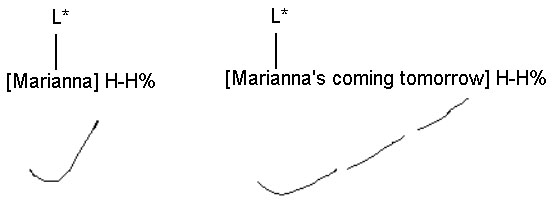
3. L-H% boundary tone
L-H% (continuation-rise)The pitch is low and then rises at the end of the prosodic phrase.

Some common usages of L-H%

Examples of L-L% (1), H-H% (2), L-H% (3)
4. H-L% boundary tone
H-L% The pitch is high and then falls slightly at the end of the prosodic phrase.

It is sometimes used in list recital to convey a somewhat disinterested tone
Pitch Contours and Boundary Tones
When the nuclear accented word is early in the prosodic phrase the pitch contour of a large part of the prosodic phrase is controlled by the boundary tone.

The pitch falls immediately after the /æ/ of 'Anna', then stays lows until the end of the phrase when it rises.
The pitch is low on the /æ/ of 'Anna', then rises continually to a high value at the end of the phrase.

As above
Content owner: Department of Linguistics Last updated: 12 Mar 2024 9:50am

